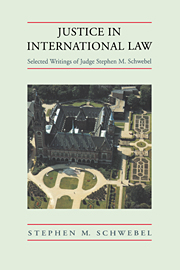Book contents
- Frontmatter
- Contents
- Preface
- PART I International Court of Justice
- PART II International Arbitration
- PART III United Nations
- 15 The Origins and Development of Article 99 of the Charter
- 16 The International Character of the Secretariat of the United Nations
- 17 Secretary-General and Secretariat
- 18 A United Nations “Guard” and a United Nations “Legion”
- 19 Mini-States and a More Effective United Nations
- 20 Article 19 of the Charter of the United Nations: Memorandum of Law
- 21 The United States Assaults the ILO
- 22 Goldberg Variations
- PART IV International Contracts and Expropriation
- PART V Aggression under, Compliance with, and Development of International Law
- List of publications
- Index
18 - A United Nations “Guard” and a United Nations “Legion”
Published online by Cambridge University Press: 06 November 2009
- Frontmatter
- Contents
- Preface
- PART I International Court of Justice
- PART II International Arbitration
- PART III United Nations
- 15 The Origins and Development of Article 99 of the Charter
- 16 The International Character of the Secretariat of the United Nations
- 17 Secretary-General and Secretariat
- 18 A United Nations “Guard” and a United Nations “Legion”
- 19 Mini-States and a More Effective United Nations
- 20 Article 19 of the Charter of the United Nations: Memorandum of Law
- 21 The United States Assaults the ILO
- 22 Goldberg Variations
- PART IV International Contracts and Expropriation
- PART V Aggression under, Compliance with, and Development of International Law
- List of publications
- Index
Summary
A United Nations “Guard”: Introduction
In the introduction to his Annual Report for 1947–1948, the Secretary- General of the United Nations, Mr. Trygve Lie, described a plan he had announced during the Harvard University Commencement exercises a month earlier.
I have under study proposals for the creation of a small United Nations Guard Force which could be recruited by the Secretary-General and placed at the disposal of the Security Council and the General Assembly. Such a force would not be used as a substitute for the forces contemplated in Articles 42 and 43. It would not be a striking force, but purely a guard force. It could be used for guard duty with United Nations missions, in the conduct of plebiscites under the supervision of the United Nations and in the administration of truce terms. It could be used as a constabulary under the Security Council or the Trusteeship Council in cities like Jerusalem and Trieste during the establishment of international regimes. It might also be called upon by the Security Council under Article 40 of the Charter, which provides for provisional measures to prevent the aggravation of a situation threatening the peace.
There are many uses for such a force. If it had existed during the past year it would, I believe, have greatly increased the effectiveness of the work of the Security Council, and have saved many lives, particularly in Indonesia and Palestine. It should not be a large force – from one thousand to five thousand men would be sufficient – because it would have behind it all the authority of the United Nations.
- Type
- Chapter
- Information
- Justice in International LawSelected Writings, pp. 308 - 325Publisher: Cambridge University PressPrint publication year: 1994



